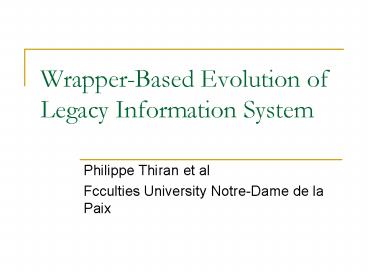Wrapper-Based Evolution of Legacy Information System - PowerPoint PPT Presentation
Title:
Wrapper-Based Evolution of Legacy Information System
Description:
Wrapper-Based Evolution of Legacy Information System Philippe Thiran et al Fcculties University Notre-Dame de la Paix – PowerPoint PPT presentation
Number of Views:127
Avg rating:3.0/5.0
Title: Wrapper-Based Evolution of Legacy Information System
1
Wrapper-Based Evolution of Legacy Information
System
- Philippe Thiran et al
- Fcculties University Notre-Dame de la Paix
2
Outline
- Why Data Wrappers?
- Building R/W Data Wrappers
- R/W Wrapper Architecture
- Generating Data Wrapper
3
Why Data Wrappers?
- Architectural shifts from centralized to
distributed and cooperative paradigm - Data consistency in legacy architecture
- Explicit constraints guaranteed legacy system
- Implicit constraints data consistency is
guaranteed by client application code - Example
- PR field of record type ORDER refer a definite
PRODUCT record - Implicit constraints to create or modify an
ORDER, the referred PRODUCT should be first
checked
ORDER PR
Product
4
Why Data Wrappers?
- Plug a new application component into such a
legacy architecture - How to validate the implicit data property?
- Forward Wrappers
- Translate data and queries from the legacy data
model - Take charge of the validation logic
5
Why Data Wrappers?
- Reuse a legacy component in a modern system
- Semantic mismatch many important constraints and
structures are ignored by data management system - Backward Wrappers
- Query and update the new data
- Data integrity is ensured by both the new and
legacy app
6
What is a Data Wrapper?
- Component inserted between the legacy database
and the application component to - Extend the lifetime of existing system
- Address the heterogeneity by providing a standard
and common interface - Allows to transparently incorporate new
capabilities - Provides a smooth path to a step-by-step
modernization of a complex legacy system - Interface of a Data Wrapper
- A wrapper schema
- A common query language
7
Outline
- Why Data Wrappers?
- Building R/W Data Wrappers
- R/W Wrapper Architecture
- Generating Data Wrapper
8
Bridge the Semantic Gap
- Data Wrapper a new application component that
query and update the contents of a legacy
database - Physical schema explicit structures and
constraints - Logical schema explicit and implicit structures,
accessed by the wrapper - By accessing the logical schema, data wrappers
address the implicit constraints - Reject the updates that violate the implicit
constraints
9
Building R/W Wrapper
- Wrapper Schema Definition
- Recover explicit constraints
- Enriched with implicit constraints by reverse
engineering techniques - Program analysis
- Data analysis
10
Building R/W Wrapper
- Mapping definition
- Transform structures
- Transform constraints
- Example of update statement
11
Outline
- Why Data Wrappers?
- Building R/W Data Wrappers
- R/W Wrapper Architecture
- Generating Data Wrapper
12
R/W Wrapper Architecture
- Query/update analysis
- Error reporting
- Query/update and data translation
- Implicit constraint control
- Security
- Concurrency and transaction management
13
Specification of a Wrapper
- GER a wide spectrum entity-relationship model
- Generate sub-models
- Retain necessary parts in the sub-model
- Rename the constructs
- Assemble the valid parts
- Advantage
- All inter-model transformations equal to
intra-model process - A limit set of primitive operators is sufficient
to model most database engineering processes - Enriched Model
- Encompass the physical, logical and conceptual
models - Define a set of constructs comprising the
structures and constraints
14
Model and Schema Specification
- Constructs entity types, attribute, relationship
types - Built-in Constraints
15
Transformational Mapping Spec
- Transform a schema from one model to another,
requiring specific operators - Inverse transformation
- T2(T1(C))C
- Transformation sequence
- S1-to-S2(T1 T2 ... Tn) S2T2(T1(S1))
- S2-to-S1(Tn-1 T2-1 T1-1) S1S2-to-S1(S2)
- Transformation categories
- T augment the semantics of the schema
- T Preserve the semantics of the schema
- T- Reduce the semantics of the schema
- Implicit constraints and schema Interpretation
16
Outline
- Why Data Wrappers?
- Building R/W Data Wrappers
- R/W Wrapper Architecture
- Generating Data Wrapper
17
Generating Wrapper
- Database reverse engineering
- Yield all the necessary information to specify
and develop a wrapper - Semi-hardcoded wrapper
- A model layer and a database layer
- Schema transformation-based wrapper generation
- T is used to specify the implicit constraint
assertions instead of T - Operational CASE support
- Schema processing, mapping processing, and
wrapper generation
18
Database Reverse Engineering
- Results
- Wrapper schema
- Schema transformation sequence
- Process
- Physical extraction
- Logical extraction
- Wrapper schema derivation
- Mapping definition
19
Wrapper Generation
20
Wrapper Generation
- The results from DBRE
- Legacy physical schema
- Legacy logical schema
- Wrapper schema
- LS-to-PS mapping is formally defined, used to
code the implicit constraint control component - Structural part of WS-to-LS is used to code the
query/update translator - Instance part of ls-to-ws define the data
translator
21
Reference
- Thiran, P. et al, Wrapper-Based Evoluation of
Legacy Information System, ACM Tran Software
Engineering and Methodology Vol.15 No.4, October
2006 - Brodie, M. et al. 1995. Migrating Legacy Systems,
Morgan Kaufmann - Haninaut, J. et al, 2005, Transformation-Based
Database Engineering, IDEA Group
22
- Thanks
- Questions?































